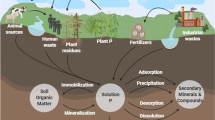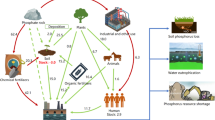Abstract
This study aims to evaluate the practical potential of using constructed wetlands (CWs) for treating saline wastewater containing various heavy metals. The results demonstrated that CWs growing Canna indica with porous slag as substrate could efficiently remove heavy metals (Cu, Zn, Cd, and Pb) from saline wastewater at an electrical conductivity (EC) of 7 mS/cm, especially under low influent load. Salts with salinity level (characterized as EC) of 30 mS/cm suppressed the removal of some heavy metals, dependent on heavy metal species and their influent concentrations. The presence of salts in CWs can improve the accumulation of Cu, Zn, and Pb in plant tissues as compared to control treatment, irrespective of metal concentrations in solution. The influence of salts on Cd accumulation depended on both salinity levels and Cd concentrations in solution. Although more heavy metals were accumulated in roots than in shoots, the harvesting of aboveground plant materials is still efficient addition for heavy metal removal due to the greater biomass and growth rate of aboveground plant material. Furthermore, replacing all plants instead of preserving roots from harvested plants in CWs over a period of time is essential for heavy metal removal, because the continued accumulation by roots can be inhibited by the increasing accumulated heavy metals from saline wastewater.










Similar content being viewed by others
References
A D, Oka M, Fujii Y, Soda S, Ishigaki T, Machimura T, Ike M (2017) Removal of heavy metals from synthetic landfill leachate in lab-scale vertical flow constructed wetlands. Sci Total Environ 584:742–750
Al-Shannag M, Al-Qodah Z, Bani-Melhem K, Qtaishat MR, Alkasrawi M (2015) Heavy metal ions removal from metal plating wastewater using electrocoagulation: kinetic study and process performance. Chem Eng J 260:749–756
Arivoli A, Mohanraj R, Seenivasan R (2015) Application of vertical flow constructed wetland in treatment of heavy metals from pulp and paper industry wastewater. Environ Sci Pollut Res 22(17):13336–13343
Bakhshoodeh R, Alavi N, Mohammadi AS, Ghanavati H (2016) Removing heavy metals from Isfahan composting leachate by horizontal subsurface flow constructed wetland. Environ Sci Pollut Res 23(12):12384–12391
Bilal M, Shah JA, Ashfaq T, Gardazi SMH, Tahir AA, Pervez A, Haroon H, Mahmood Q (2013) Waste biomass adsorbents for copper removal from industrial wastewater—a review. J Hazard Mater 263:322–333
Cao JS, Wang C, Fang F, Lin JX (2016) Removal of heavy metal Cu(II) in simulated aquaculture wastewater by modified palygorskite. Environ Pollut 219:924–931
Chen SC, Grosse W, Karrenbrock F, Thoennessen M (2002) Efficiency of constructed wetlands in decontamination of water polluted by heavy metals. Ecol Eng 18(3):317–325
Cui X, Hao H, Zhang C, He Z, Yang X (2016) Capacity and mechanisms of ammonium and cadmium sorption on different wetland-plant derived biochars. Sci Total Environ 539(Supplement C):566–575
Du Laing G, De Vos R, Vandecasteele B, Lesage E, Tack FMG, Verloo MG (2008) Effect of salinity on heavy metal mobility and availability in intertidal sediments of the Scheldt estuary. Estuar Coast Shelf S 77(4):589–602
Fang L, Li L, Qu Z, Xu H, Xu J, Yan N (2018) A novel method for the sequential removal and separation of multiple heavy metals from wastewater. J Hazard Mater 342(Supplement C):617–624
Gill LW, Ring P, Casey B, Higgins NMP, Johnston PM (2017) Long term heavy metal removal by a constructed wetland treating rainfall runoff from a motorway. Sci Total Environ 601:32–44
Hayashi M (2004) Temperature-electrical conductivity relation of water for environmental monitoring and geophysical data inversion. Environ Monit Assess 96(1–3):119–128
Helal HM, Haque SA, Ramadan AB, Schnug E (1996) Salinity heavy metal interactions as evaluated by soil extraction and plant analysis. Commun Soil Sci Plan Anal 27(5–8):1355–1361
Hu XF, Jiang Y, Shu Y, Hu X, Liu L, Luo F (2014) Effects of mining wastewater discharges on heavy metal pollution and soil enzyme activity of the paddy fields. J Geochem Explor 147(Part B):139–150
Huber M, Hilbig H, Badenberg SC, Fassnacht J, Drewes JE, Helmreich B (2016) Heavy metal removal mechanisms of sorptive filter materials for road runoff treatment and remobilization under de-icing salt applications. Water Res 102:453–463
Jiang XL, Xiong ZQ, Liu H, Liu GH, Liu WZ (2017) Distribution, source identification, and ecological risk assessment of heavy metals in wetland soils of a river-reservoir system. Environ Sci Pollut Res 24(1):436–444
Kaseva ME, Mbuligwe SE (2010) Potential of constructed wetland systems for treating tannery industrial wastewater. Water Sci Technol 61(4):1043–1052
Kerkar S, Ranjan Das K (2017) Bioremediation of heavy metals from saline water using hypersaline dissimilatory sulfate-reducing bacteria. In: Naik MM, Dubey SK (eds) Marine pollution and microbial remediation. Springer Singapore, Singapore, pp 15–28
Li C, Xu Y, Jiang W, Dong X, Wang D, Liu B (2013) Effect of NaCl on the heavy metal tolerance and bioaccumulation of Zygosaccharomyces rouxii and Saccharomyces cerevisiae. Bioresour Technol 143:46–52
Liang Y, Zhu H, Bañuelos G, Yan B, Shutes B, Cheng X, Chen X (2017) Removal of nutrients in saline wastewater using constructed wetlands: plant species, influent loads and salinity levels as influencing factors. Chemosphere 187(Supplement C):52–61
Maine M, Sune N, Hadad H, Sánchez G, Bonetto C (2006) Nutrient and metal removal in a constructed wetland for wastewater treatment from a metallurgic industry. Ecol Eng 26(4):341–347
Matagi S, Swai D, Mugabe R (1998) A review of heavy metal removal mechanisms in wetlands. Afr J Trop Hydrobiol Fish 8(1):13–25
Mesa J, Mateos-Naranjo E, Caviedes MA, Redondo-Gómez S, Pajuelo E, Rodríguez-Llorente ID (2015) Scouting contaminated estuaries: heavy metal resistant and plant growth promoting rhizobacteria in the native metal rhizoaccumulator Spartina maritima. Mar Pollut Bull 90(1–2):150–159
Nelson SS, Yonge DR, Barber ME (2009) Effects of road salts on heavy metal mobility in two eastern Washington soils. J Environ Eng ASCE 135(7):505–510
Ovečka M, Takáč T (2014) Managing heavy metal toxicity stress in plants: biological and biotechnological tools. Biotechnol Adv 32(1):73–86
Piatak NM, Parsons MB, Seal RR (2015) Characteristics and environmental aspects of slag: a review. Appl Geochem 57:236–266
Qin, R., Chen, H., 2016. The procession of constructed wetland removal mechanism of pollutants. 4th international conference on mechanical materials and manufacturing engineering (MMME), pp 568–570
Rezania S, Taib SM, Din MFM, Dahalan FA, Kamyab H (2016) Comprehensive review on phytotechnology: heavy metals removal by diverse aquatic plants species from wastewater. J Hazard Mater 318:587–599
Sheoran AS, Sheoran V (2006) Heavy metal removal mechanism of acid mine drainage in wetlands: a critical review. Miner Eng 19(2):105–116
Šíma J, Svoboda L, Pomijová Z (2016) Removal of selected metals from wastewater using a constructed wetland. Chem Biodivers 13(5):582–590
Sun H, Wang Z, Gao P, Liu P (2013) Selection of aquatic plants for phytoremediation of heavy metal in electroplate wastewater. Acta Physiol Plant 35(2):355–364
Sytar O, Kumar A, Latowski D, Kuczynska P, Strzałka K, Prasad MNV (2013) Heavy metal-induced oxidative damage, defense reactions, and detoxification mechanisms in plants. Acta Physiol Plant 35(4):985–999
Tran TK, Chiu KF, Lin CY, Leu HJ (2017) Electrochemical treatment of wastewater: selectivity of the heavy metals removal process. Int J Hydrogen Energy 42:27741–27748
Vaidyanathan H, Sivalumar P, Chakrabarty R, Thomas G (2003) Scavenging of reactive oxygen species in NaCl-stressed rice (Oryza sativa L.)—different response in salt-tolerant and sensitive varieties. Plant Sci 165(6):1411–1418
Vymazal J (2016) Concentration is not enough to evaluate accumulation of heavy metals and nutrients in plants. Sci Total Environ 544:495–498
Vymazal J, Březinová T (2016) Accumulation of heavy metals in aboveground biomass of Phragmites australis in horizontal flow constructed wetlands for wastewater treatment: a review. Chem Eng J 290:232–242
Weggler K, McLaughlin MJ, Graham RD (2004) Effect of chloride in soil solution on the plant availability of biosolid-borne cadmium. J Environ Qual 33(2):496–504
Weis JS, Weis P (2004) Metal uptake, transport and release by wetland plants: implications for phytoremediation and restoration. Environ Int 30(5):685–700
Wen J, Tao W, Wang Z, Pei Y (2013) Enhancing simultaneous nitritation and anammox in recirculating biofilters: effects of unsaturated zone depth and alkalinity dissolution of packing materials. J Hazard Mater 244–245(Supplement C):671–680
Wu S, Wallace S, Brix H, Kuschk P, Kirui WK, Masi F, Dong R (2015) Treatment of industrial effluents in constructed wetlands: challenges, operational strategies and overall performance. Environ Pollut 201(Supplement C):107–120
Xu J, Zhao G, Huang X, Guo H, Liu W (2017) Use of horizontal subsurface flow constructed wetlands to treat reverse osmosis concentrate of rolling wastewater. Int J Phytoremediat 19(3):262–269
Yang Q, Chen ZH, Zhao JG, Gu BH (2007) Contaminant removal of domestic wastewater by constructed wetlands: effects of plant species. J Integr Plant Biol 49(4):437–446
Zhang W, Liu X, Cheng H, Zeng EY, Hu Y (2012a) Heavy metal pollution in sediments of a typical mariculture zone in South China. Mar Pollut Bull 64(4):712–720
Zhang Z, Cui B, Fan X (2012b) Removal mechanisms of heavy metal pollution from urban runoff in wetlands. Front Earth Sci 6(4):433–444
Zhang XP, Liu FQ, Zhu CQ, Xu C, Chen D, Wei MM, Liu J, Li CH, Ling C, Li AM (2015) A novel tetraethylenepentamine functionalized polymeric adsorbent for enhanced removal and selective recovery of heavy metal ions from saline solutions. RSC Adv 5(93):75985–75997
Acknowledgements
This work was supported by the National Key R&D Program of China (No.2016YFC0500404-4), the National Natural Science Foundation of China (No. 41471406), and the Youth Innovation Promotion Association of CAS (No. 2017274).
Author information
Authors and Affiliations
Corresponding author
Additional information
Responsible editor: Elena Maestri
Electronic supplementary material
ESM 1
(DOCX 196 kb)
Rights and permissions
About this article
Cite this article
Liang, Y., Zhu, H., Bañuelos, G. et al. Preliminary study on the dynamics of heavy metals in saline wastewater treated in constructed wetland mesocosms or microcosms filled with porous slag. Environ Sci Pollut Res 26, 33804–33815 (2019). https://doi.org/10.1007/s11356-018-2486-0
Received:
Accepted:
Published:
Issue Date:
DOI: https://doi.org/10.1007/s11356-018-2486-0




